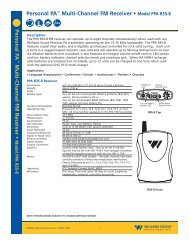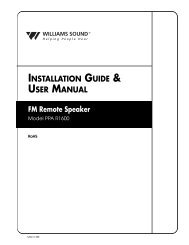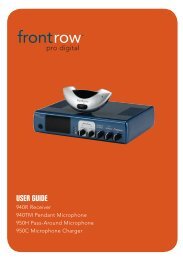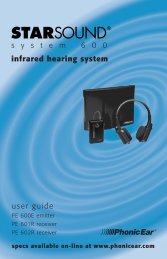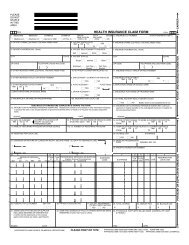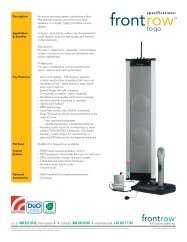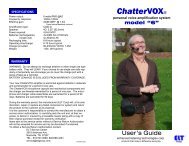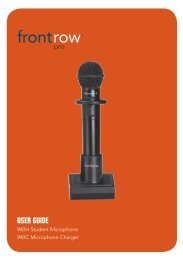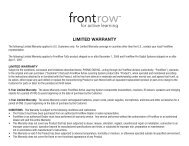FrontRow Symbio User Guide - Centrum Sound
FrontRow Symbio User Guide - Centrum Sound
FrontRow Symbio User Guide - Centrum Sound
Create successful ePaper yourself
Turn your PDF publications into a flip-book with our unique Google optimized e-Paper software.
16 Regulatory<br />
receiver: part 15, subpart B<br />
<strong>FrontRow</strong> <strong>Symbio</strong> Receiver<br />
5201R<br />
Tested to comply with<br />
FCC Standards<br />
This product conforms with the<br />
essential requirements of European<br />
Union Directive /EU Directive<br />
2004/108/EC EMC Directive and 2002/95<br />
ROHS Directive. This product can be subject<br />
to interference at our operational frequency<br />
bands of 2.3 and 2.8 MHz.<br />
For home or office use<br />
This equipment has been tested and found<br />
to comply with the limits for a Class B digital<br />
device, pursuant to Part 15 of the FCC Rules.<br />
These limits are designed to provide reasonable<br />
protection against harmful interference<br />
in a residential installation. This equipment<br />
generates, uses and can radiate radio frequency<br />
energy and, if not installed and used<br />
in accordance with the instructions, may<br />
cause harmful interference to radio communications.<br />
However, there is no guarantee<br />
that interference will not occur in a particular<br />
installation.<br />
FCC notes<br />
The <strong>FrontRow</strong> <strong>Symbio</strong> system is approved<br />
by the FCC (Federal Communications<br />
Commission). The use of the system may<br />
be governed by specific FCC rules and FCC<br />
licensing or notifications may be required.<br />
Consult your local FCC office for detailed<br />
information.<br />
Phonic Ear receivers and transmitters, when<br />
required, are approved by the Federal<br />
Communications Commission (FCC) in the<br />
U.S. and Industry Canada. Other government<br />
approvals are available upon request. (Other<br />
international regulations may also apply.)<br />
Any changes or modifications made to any<br />
government-approved element of this instrument,<br />
without the express approval of<br />
Phonic Ear, Inc. in writing, could void the<br />
user's authority to operate those elements<br />
of the system.<br />
Electrical and electronic<br />
equipment (EEE) contains<br />
materials, components and<br />
substances, that could be<br />
dangerous or detrimental to human health<br />
and the environment if waste electrical and<br />
electronic equipment (WEEE) is not disposed<br />
of correctly. Products marked with the<br />
crossed-out dustbin shown here are electrical<br />
and electronic equipment. The crossed-out<br />
dustbin indicates that waste electrical and<br />
electronic equipment may not be disposed<br />
of with unsorted household waste and that it<br />
must be collected separately.<br />
In developing and manufacturing your Phonic<br />
Ear product, we used high-quality materials<br />
and components that can be reused. Thus,<br />
when disposing of your waste electrical<br />
and electronic equipment, you must use a<br />
collection system designated for this purpose,<br />
regardless of whether you dispose of your<br />
waste at your local waste site or it is collected<br />
from your home. Please contact your local<br />
authority for further information.<br />
IC notes<br />
This Class B digital apparatus complies with<br />
Canadian ICES-003.<br />
Cet appareil numérique de la classe B est<br />
conforme à la norme NMB-003 du Canada.<br />
The term "IC:" before the radio certification<br />
number only signifies that Industry of Canada<br />
technical specifications were met.<br />
24



